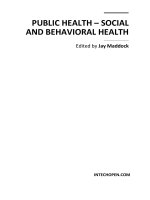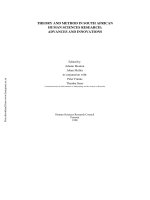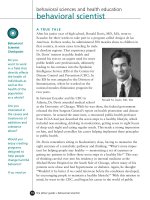Protecting Participants and Facilitating Social and Behavioral Sciences Research doc
Bạn đang xem bản rút gọn của tài liệu. Xem và tải ngay bản đầy đủ của tài liệu tại đây (1.31 MB, 277 trang )
THE NATIONAL ACADEMIES PRESS 500 Fifth Street, NW Washington, DC 20001
NOTICE: The project that is the subject of this report was approved by the Governing
Board of the National Research Council, whose members are drawn from the councils
of the National Academy of Sciences, the National Academy of Engineering, and the
Institute of Medicine. The members of the committee responsible for the report were
chosen for their special competences and with regard for appropriate balance.
The project that is the subject of this report was supported by contract no.
SBR-9709489 between the National Academy of Sciences and the National Science
Foundation. Any opinions, findings, conclusions, or recommendations expressed in this
publication are those of the author(s) and do not necessarily reflect the views of the
organizations or agencies that provided support for the project.
International Standard Book Number 0-309-08852-6 (book)
International Standard Book Number 0-309-51136-4 (PDF)
Library of Congress Control Number: 2003106396
Additional copies of this report are available from the National Academies Press, 500
Fifth Street, NW, Washington, D.C. 20001; (202) 334-3096; Internet,
Copyright 2003 by the National Academy of Sciences. All rights reserved.
Printed in the United States of America
Suggested citation: National Research Council (2003). Protecting Participants and
Facilitating Social and Behavioral Sciences Research. Panel on Institutional Review
Boards, Surveys, and Social Science Research. Constance F. Citro, Daniel R. Ilgen, and
Cora B. Marrett, eds. Committee on National Statistics and Board on Behavioral,
Cognitive, and Sensory Sciences. Washington, DC: The National Academies Press.
The National Academy of Sciences is a private, nonprofit, self-perpetuating so-
ciety of distinguished scholars engaged in scientific and engineering research,
dedicated to the furtherance of science and technology and to their use for the
general welfare. Upon the authority of the charter granted to it by the Congress
in 1863, the Academy has a mandate that requires it to advise the federal gov-
ernment on scientific and technical matters. Dr. Bruce M. Alberts is president
of the National Academy of Sciences.
The National Academy of Engineering was established in 1964, under the char-
ter of the National Academy of Sciences, as a parallel organization of outstand-
ing engineers. It is autonomous in its administration and in the selection of its
members, sharing with the National Academy of Sciences the responsibility for
advising the federal government. The National Academy of Engineering also
sponsors engineering programs aimed at meeting national needs, encourages
education and research, and recognizes the superior achievements of engi-
neers. Dr. Wm. A. Wulf is president of the National Academy of Engineering.
The Institute of Medicine was established in 1970 by the National Academy of
Sciences to secure the services of eminent members of appropriate professions
in the examination of policy matters pertaining to the health of the public.
The Institute acts under the responsibility given to the National Academy of
Sciences by its congressional charter to be an adviser to the federal govern-
ment and, upon its own initiative, to identify issues of medical care, research,
and education. Dr. Harvey V. Fineberg is president of the Institute of Medicine.
The National Research Council was organized by the National Academy of
Sciences in 1916 to associate the broad community of science and technology
with the Academy’s purposes of furthering knowledge and advising the federal
government. Functioning in accordance with general policies determined by
the Academy, the Council has become the principal operating agency of both
the National Academy of Sciences and the National Academy of Engineering
in providing services to the government, the public, and the scientific and en-
gineering communities. The Council is administered jointly by both Academies
and the Institute of Medicine. Dr. Bruce M. Alberts and Dr. Wm. A. Wulf are
chair and vice chair, respectively, of the National Research Council.
www.national-academies.org
PANEL ON INSTITUTIONAL REVIEW BOARDS, SURVEYS, AND
SOCIAL SCIENCE RESEARCH
C
ORA B. MARRETT (Chair), Academic Affairs, University of Wisconsin
System Administration
D
ANIEL R. ILGEN (Vice Chair), Department of Psychology and
Management, Michigan State University
T
ORA KAY BIKSON, Department of Behavioral Sciences, The RAND
Corporation, Santa Monica, California
R
OBERT M. GROVES, Survey Research Center, University of
Michigan, and Joint Program in Survey Methodology
R
OBERT M. HAU SER, Center for Demography of Health and Aging,
University of Wisconsin-Madison
V. J
OSEPH HOTZ, Department of Economics, University of California
at Los Angeles
P
AT R I C IA MARSHALL, Department of Biomedical Ethics, Case
Western Reserve University
A
NNA C. MASTROIANNI, School of Law and Institute for Public
Health Genetics, University of Washington
J
OHN J. MCARDLE, Department of Psychology, University of Virginia
ELEANOR SINGER, Institute for Social Research, University of
Michigan
W
ILLIAM A. YOST (Liaison), Board on Behavioral, Cognitive, and
Sensory Sciences; Graduate School, Loyola University, Chicago
C
ONSTANCE F. C ITRO, Study Director
J
AMIE CASEY, Research Assistant
T
ANYA M. LEE, Project Assistant
v
COMMITTEE ON NATIONAL STATISTICS
2003
J
OHN E. ROLPH (Chair), Marshall School of Business, University of
Southern California
J
OSEPH G. ALTONJI, Department of Economics, Yale University
R
OBERT M. BELL, AT&T Labs—Research, Florham Park, New Jersey
L
AWRENCE D. BROWN, Department of Statistics, The Wharton
School, University of Pennsylvania
R
OBERT M. GROVES, Survey Research Center, University of
Michigan, and Joint Program in Survey Methodology
J
OEL L. HOROWITZ, Department of Economics, Northwestern
University
W
ILLIAM KALSBEEK, Survey Research Unit, Department of
Biostatistics, University of North Carolina
A
RLEEN LEIBOWITZ, School of Public Policy and Social Research,
University of California at Los Angeles
T
HOMAS A. LOUIS, Bloomberg School of Public Health, Johns
Hopkins University
V
IJAYAN NAIR, Department of Statistics and Department of Industrial
and Operations Engineering, University of Michigan
D
ARYL PREGIBON, AT&T Labs—Research, Florham Park, New Jersey
K
ENNETH PREWIT T, School of Public Affairs, Columbia University
N
ORA CATE SCHAEFFER, Department of Sociology, University of
Wisconsin-Madison
M
ATT H E W D. SHAPIRO, Department of Economics, University of
Michigan
A
NDREW A. WHITE, Director
vi
BOARD ON BEHAVIORAL, COGNITIVE,
AND SENSORY SCIENCES
2003
A
NNE PETERSEN (Chair), W.K. Kellogg Foundation, Battle Creek,
Michigan
L
INDA MARIE BURTON, Center for Human Development and Family
Research, Pennsylvania State University
S
TEPHEN J. CECI, Department of Human Development, Cornell
University
E
UGENE K. EMORY, Department of Psychology, Emory University
R
OCHEL GELMAN, Department of Psychology and Cognitive Science,
Rutgers University
A
NTHONY W. JACKSON, The Galef Institute, Los Angeles, California
P
ETER LENNIE, Dean for Science, New York University
M
ARCIA C. LINN, Graduate School of Education, University of
California at Berkeley
E
LISSA L. NEWPORT, Department of Brain and Cognitive Sciences,
University of Rochester
C
HARLES R. PLOTT, Division of Humanities and Social Sciences,
California Institute of Technology
M
ICHAEL L. RUTTER, Social, Genetic, and Developmental Psychiatry
Research Centre, University of London
A
RNOLD SAMEROFF, Center for Human Growth and Development,
University of Michigan
J
AMES W. S TIGLER, Department of Psychology, University of
California at Los Angeles
W
ILLIAM A. YOST, Graduate School, Loyola University, Chicago
C
HRISTINE R. HARTEL, Director
vii
Acknowledgments
The Panel on Institutional Review Boards, Surveys, and Social Sci-
ence Research thanks the many people who contributed their time and
expertise to the preparation of this report.
We are grateful to everyone who attended the panel’s first meet-
ing and provided perspectives on issues of human research participant
protection in the social, behavioral, and economic sciences (SBES).
We acknowledge the wealth of information that we obtained from web-
sites of private and public organizations and from previous surveys
of the review process for research with human participants (see the
appendices). We also acknowledge the very useful paper by George
Duncan, of Carnegie Mellon University, on confidentiality and data ac-
cess issues for institutional review boards (IRBs), which is reproduced
as Appendix E. We thank the staff of the National Research Council
for their helpful advice and input, including Andrew White, director
of the Committee on National Statistics; Christine Hartel, director of
the Board on Behavioral, Cognitive, and Sensory Sciences; and Laura
Lyman Rodriguez and Jessica Aungst, staff to the Institute of Medicine
Committee on Assessing the System for Protecting Human Research
Participants. That committee produced the very useful report, Respon-
sible Research, which provides an invaluable perspective on the work
of IRBs, primarily in the biomedical fields. Eugenia Grohman, director
of the reports office of the Division of Behavioral and Social Sciences
and Education, made important contributions to our report through
her fine technical editing.
Our panel was assisted by a very able staff. We are grateful to Vir-
ginia A. deWolf, n ow at the U.S. Bureau of Transportation Statistics,
who served as the panel’s first study director. She did a masterful job of
organizing the panel’s meetings, reaching out to other groups that are
active in human research participant protection issues, and assembling
a wealth of background materials to inform the panel’s deliberations.
Jamie Casey conducted the panel’s review of websites of 47 major re-
search institutions to determine their guidance and policies for review
of research protocols involving human participants, tracked down of-
ten obscure materials for the panel’s use, and assisted the panel at
its meetings. Tanya Lee made excellent arrangements for panel meet-
ix
ings. Daniel Cork contributed his outstanding typographic skills to the
preparation of the report for printing.
The panel is especially grateful to Constance Citro, who served as
the panel’s study director beginning in May 2002. She insisted that our
work reflect the highest standards of evidence and worked unfailingly
to uncover sources for that evidence. We draw attention in particular
to the synthesis she developed on the evolution of federal guidelines for
the protection of human participants in research, which is recounted
in Chapter 3. From disparate sources, she developed a coherent and
original account of that process. More broadly, with extraordinary dili-
gence, she managed the completion of the panel’s work.
I want to extend special thanks to Daniel Ilgen, who served as vice
chair of the panel. He assumed the role despite a lengthy list of other
commitments. He listened to our deliberations and crafted arguments
noteworthy for their clarity. He worked tirelessly with Connie to ensure
that our efforts warranted the imprimatur of the National Research
Council.
All of the panel members made important contributions of their
time and expertise, not only bringing to bear examples and perspec-
tives from their own specialties, but also engaging in intensive dialogue
to reach consensus on key issues for participant protection in SBES re-
search. It was an honor to serve with them.
The panel also benefited from our two liaison members. William
Yost, Loyola University, Chicago, liaison from the Board on Behav-
ioral, Cognitive, and Sensory Sciences to our panel, attended all our
meetings and provided a very useful perspective to the panel’s deliber-
ations. Roderick J.A. Little, University of Michigan, attended our early
meetings as liaison from both the IOM committee and the Committee
on National Statistics.
This report has been reviewed in draft form by individuals chosen
for their diverse perspectives and technical expertise, in accordance
with procedures approved by the National Research Council’s Report
Review Committee. The purpose of this independent review is to pro-
vide candid and critical comments that will assist the institution in
making its published report as sound as possible and to ensure that
the report meets institutional standards for objectivity, evidence, and
responsiveness to the study charge. The review comments and draft
manuscript remain confidential to protect the integrity of the delibera-
tive process.
We wish to thank the following individuals for their review of this
report: Evan G. DeRenzo, Center for Ethics, Washington Hospital Cen-
ter, Washington, DC; Lowell W. Gerson, Office of Addiction Medicine,
Northeastern Ohio Universities College of Medicine, Rootstown, OH;
x
Jeff Kahn, Center for Bioethics, University of Minnesota; Richard A.
Kulka, Research Triangle Institute, Research Triangle Park, NC; Rod-
erick J.A. Little, Department of Biostatistics, University of Michigan;
Richard E. Nisbett, Culture and Cognition Program and Department
of Psychology, University of Michigan; Lee N. Robins, Department of
Psychiatry, Washington University School of Medicine, St. Louis, MO;
and Joan E. Sieber, Department of Psychology, California State Univer-
sity, Hayward.
Although the reviewers listed above have provided many construc-
tive comments and suggestions, they were not asked to endorse the
conclusions or recommendations nor did they see the final draft of the
report before its release. The review of this report was overseen by
Henry W. Riecken, Behavioral Sciences, University of Pennsylvania,
and Mary Jane Osborn, Department of Microbiology, University of Con-
necticut Health Center. Appointed by the National Research Council,
they were responsible for making certain that an independent exami-
nation of this report was carried out in accordance with institutional
procedures and that all review comments were carefully considered.
Responsibility for the final content of this report rests entirely with the
authoring committee and the institution.
Cora B. Marrett, Chair
Panel on Institutional Review Boards,
Surveys, and Social Science Research
xi
Contents
Executive Summary 1
Panel Charge and Scope 1
Enhancing Informed Consent 2
Enhancing Confidentiality Protection 4
Effective Review of Minimal-Risk Research 5
Needed Information 7
System-Level Issues 7
1 Introduction 9
The Issues 10
Panel Charge and Scope 11
Activities 14
Organization of Report 15
2 Basic Concepts 23
Principles and Practices for Ethical Research 23
Harms, Risks, and Benefits 26
Minimal Risk 31
Role of IRBs 35
SBES Research 43
Conclusion 53
3 Regulatory History 59
From 1945 to 1966 60
From 1966 to 1974 61
From 1974 to 1981 64
From 1981 to 1991 73
Developments Since 1991 74
Conclusion 79
4 Enhancing Informed Consent 81
IRB Focus on Informed Consent 86
Research to Improve Consent Procedures 93
Informed Consent for Special Populations 94
Third-Party Consent 98
Waiving Written Consent 101
xiii
Omitting Elements of Informed Consent 108
Conclusion 111
5 Enhancing Confidentiality Protection 113
History of Confidentiality Protection in the Participant
Protection System 115
Confidentiality Protection in the Federal Statistical System 119
Protecting Confidentiality Today 123
The Role of Researchers, IRBs, OHRP, and Funding Agencies
in Protecting Confidentiality 133
A Confidentiality Protection System for Public-Use Microdata 138
Concluding Note: Minimal Disclosure Risk is Not Zero Risk 140
6 Enhancing the Effectiveness of Review: Minimal-Risk
Research 143
Guidance on the Review Process 144
Guidance for Initial Review 146
Continuing Review 157
Documenting Risks and Harms 159
Ongoing Data System 160
In-Depth Studies 163
7 System Issues 165
Guidance and Support for IRBs 166
Qualifications and Performance Standards 168
Communication Among IRBs and Researchers 171
Organization of and Among IRBs 175
Developing National Policy for Human Research Participant
Protection 178
Continuing System Evolution 180
References 183
Appendices 191
A Tracing Changes in Regulatory Language 193
B Selected Organizations and Resources for Human Research
Participant Protection 217
C Agenda for Panel’s First Meeting 221
D Selected Studies of IRB Operations: Summary Descriptions 225
xiv
E Confidentiality and Data Access Issues for Institutional
Review Boards George T. Duncan 235
Introduction 235
Critical Issues 236
Tension Between Disclosure Risk and Data Utility 242
Conclusions 247
References and Bibliography 247
Biographical Sketches of Panel Members and Staff 253
xv
List of Figures
2-1 Types of Possible Harm Anticipated by Investigators for Protocols, by Type
of Research 29
2-2 Average Reviews by IRBs in Each Decile of Workload Volume, 1995 37
2-3 SBES and Biomedical Protocols by Type of Method Used 46
6-1 Boxplots for Hypothetical Proportion of Expedited Reviews Across IRBs 163
xvi
List of Boxes
1-1 Key Features of the Common Rule 17
1-2 Categories of Research for Which Minimal-Risk Protocols Can Receive
Expedited Review 20
2-1 Laboratory Experiment Examples 48
2-2 Field Experiment Examples 49
2-3 Natural Behavior Observation Examples 51
2-4 Unstructured or Semistructured Interview Examples 54
2-5 Structured Interview (Sample Survey) Examples 56
2-6 Secondary Analysis Examples 57
3-1 Examples of Ethically Troubling SBES Research from the 1970s 66
3-2 SBES Concerns in the 1970s 68
4-1 Basic Elements of Informed Consent 82
4-2 Additional Elements of Informed Consent and Provisions for Waiver or
Alteration 84
4-3 Documentation of Consent and Waiver Conditions 85
5-1 Health and Retirement Survey Design and Content 126
A-1 Applicability of IRB Regulations 194
A-2 Definition of Research 195
A-3 Definition of Human Subject 196
A-4 Research Eligible for Exemption 197
A-5 Expedited Review (SBES-Related Categories) 200
A-6 Criteria for IRB Review 203
A-7 Basic Elements of Informed Consent 206
A-8 Additional Elements of Informed Consent 209
A-9 Conditions for Waiver of Informed Consent 211
A-10 Documentation of Informed Consent and Waiver Conditions 213
A-11 Definition of Minimal Risk 216
xvii
Executive Summary
T
HE U.S. SYSTEM for protecting people who volunteer to partic-
ipate in research is widely perceived to need improvement. A
major concern is that the linchpins of the protection system—
institutional review boards (IRBs)—are overloaded and underfunded
and so may not be able to adequately protect participants from harm
in high-risk research, such as clinical trials of experimental drugs.
Three other concerns—often voiced about research in the social,
behavioral, and economic sciences (SBES), but generally applicable to
human participant protection—are important. The first is that the re-
view process too often focuses on documenting consent to participate
in research so as to satisfy the letter of federal requirements, when
IRBs and researchers instead need to focus on developing the most
effective processes for helping individuals reach an informed, volun-
tary decision about participation. The second concern is that IRBs, re-
searchers, and the entire human participant protection system may pay
too little attention to the challenge of countering increasing threats to
the confidentiality of research data because of technological and other
changes, such as the ability to readily access and link large databases
through the Internet. The third concern is that the review process may
delay research or impair the integrity of research designs, without nec-
essarily improving participant protection, because the type of review
is not commensurate with risk—for example, full board review for
minimal-risk research that uses such methods as surveys, structured
interviews, participant observation, laboratory experiments, and anal-
yses of existing data.
PANEL CHARGE AND SCOPE
The Panel on Institutional Review Boards, Surveys, and Social Sci-
ence Research was established by the Committee on National Statistics
and the Board on Behavioral, Cognitive, and Sensory Sciences, both
standing committees of the National Academies’ National Research
Council. The panel was charged to examine the structure, function,
and performance of the IRB system as it relates to SBES research and
to recommend research and practice to improve the system.
1
2 PROTECTING PARTICIPANTS AND FACILITATING SOCIAL AND BEHAVIORAL SCIENCES RESEARCH
Our panel’s work complements that of the Institute of Medicine’s
Committee on Assessing the System for Protecting Human Research
Participants, which issued its final report, Responsible Research, in
2002. That report addresses primarily the problems of high-risk re-
search. We commend that report, which stresses that participant pro-
tection in the United States is a dynamic system of many actors. The
report makes useful recommendations to virtually all actors, includ-
ing the Congress, the Office for Human Research Protections (OHRP)
in the U.S. Department of Health and Human Services, agencies that
support research and collect data for research use, high officials of
research institutions, IRBs, researchers, individual participants, and
many interested associations and other organizations.
Although addressed primarily to SBES research, our findings and
recommendations have broader application given that the boundaries
between research domains are not and cannot be sharply drawn. We
address three topics in depth: issues for obtaining informed, voluntary
consent; issues for protecting data confidentiality; and review proce-
dures for minimal-risk research. We c onsider more briefly system-level
issues regarding the relationships and interactions among actors in-
volved in participant protection. Throughout, we stress commitment
to upholding the principles for ethical research articulated in the land-
mark 1979 Belmont Report: respect for persons (informed consent),
beneficence (minimizing risks and maximizing benefits of research),
and justice (selection of participants in ways that fairly distribute the
burdens and benefits of research). Given scarce IRB resources, we be-
lieve that commitment to protection requires that review procedures
be commensurate with risk. The Common Rule regulations (“Federal
Policy for the Protection of Human Subjects”) contain sufficient flexi-
bility for this purpose: the challenge is how best to encourage IRBs to
use the flexibility in the regulations appropriately for different types of
research methods, topics, and study populations.
ENHANCING INFORMED CONSENT
Informed consent is a bedrock principle of ethical research with
human participants. For more-than-minimal-risk research, a process
that allows consent to be truly informed is critical; for minimal-risk re-
search, such a process respects individual autonomy. Despite decades
of research on consent issues, mostly in biomedical research and mostly
involving written forms, there appears to have been little progress in
devising more effective forms and procedures for achieving informed
consent or in adapting consent procedures to the needs of special pop-
EXECUTIVE SUMMARY 3
ulations (e.g., language minorities).
Recommendation 4.1: Social, behavioral, and economic
science researchers should conduct research on procedures
for obtaining and documenting informed consent that will
facilitate comprehension of benefits, harms, and risks of
harm, confidentiality protection, and other key features of
research protocols for different types of SBES research and
populations studied.
Recommendation 4.2: The Office for Human Research
Protections should develop detailed guidance for IRBs and
researchers on appropriate consent procedures for differ-
ent types of populations—including language minorities and
such vulnerable groups as undocumented immigrants—
studied in social, behavioral, and economic sciences research.
The issue of third-party consent has gained salience in recent years
due to reports of studies in which third parties complained that their
privacy was invaded by collection of sensitive data about them from
others. Examples of research that should not require third-party con-
sent, even though information about third parties is sought, are studies
in which respondents are asked about their perceptions or attitudes re-
garding others, studies in which the third person asked about is com-
pletely anonymous (e.g., a respondent’s first teacher), and studies that
present no more than minimal risk for third parties.
Recommendation 4.3: The Office for Human Research Pro-
tections should develop detailed guidance for IRBs and re-
searchers, including specific examples, on when it is and
is not necessary to obtain consent from third parties about
whom participants are asked to provide information.
The current preoccupation of the review process with the documen-
tation of consent may shift attention from protecting participants to
protecting the research institution. Requiring a signed consent form
for all types of research may inhibit participation in minimal-risk re-
search (e.g., mail surveys of the general adult population) by otherwise
willing candidates. In some situations, requiring signed written con-
sent may endanger participants when there is risk of serious harm from
breaching confidentiality and the only link of participants to the project
is the signed consent form. The Common Rule allows for waiver of
written signed consent when appropriate for minimal-risk research; it
also allows elements of informed consent (e.g., the purpose of a partic-
ular aspect of the research) to be omitted under certain circumstances.
4 PROTECTING PARTICIPANTS AND FACILITATING SOCIAL AND BEHAVIORAL SCIENCES RESEARCH
Recommendation 4.4: The Office for Human Research
Protections should develop detailed guidance for IRBs and
researchers—with clear examples for a variety of social, be-
havioral, and economic sciences research methods and
study environments—on when it is appropriate to waive
signed written consent.
Recommendation 4.5: The Office for Human Research Pro-
tections should develop detailed guidance for IRBs and re-
searchers, including specific examples, on when it is accept-
able to omit elements of informed consent in social, behav-
ioral, and economic sciences research.
ENHANCING CONFIDENTIALITY PROTECTION
Breach of confidentiality, that is, the release of data that permit
identifying an individual participant, is often the major source of po-
tential harm to participants in SBES research. For example, a survey
that poses no risk of physical injury and n o more than minor psycho-
logical annoyance may yet obtain data that could adversely affect a
respondent’s employability, insurability, or other aspects of life if it be-
came known. Even if no sensitive information is obtained, maintaining
confidentiality is required to respect participants when they have been
assured that their information will be protected.
The risk of inadvertent or advertent disclosure is increasing due
to several factors: the growing number and variety of administrative
records from public and private agencies that are readily available
on the Internet and potentially linkable to research data; the growing
number of rich, longitudinal data sets that require retention of contact
information for respondents over long periods of time and that may
be more readily linked to other data sources with sophisticated match-
ing techniques; the increased emphasis by funding agencies on data
sharing among researchers to permit replication and facilitate further
research at low cost; and the increased use of Internet-based data col-
lection technology that may be vulnerable to security breaches.
Recommendation 5.1: Becauseofincreasedrisksofiden-
tification of individual research participants with new meth-
ods of data collection and dissemination, the human research
participant protection system should continually seek to de-
velop and implement state-of-the-art disclosure protection
practices and methods. Toward this goal:
EXECUTIVE SUMMARY 5
• researchers should explicitly describe procedures to pro-
tect the confidentiality of the data to be collected in pro-
tocols they submit to IRBs;
• IRBs should pay close attention to the adequacy of pro-
posed procedures for protecting confidentiality;
• federal funding agencies should support research on
techniques to protect the confidentiality of SBES data
that are made available for research use; and
• the Office for Human Research Protections should reg-
ularly promulgate good practices in analyzing disclo-
sure risks and limiting those risks.
Increased attention to confidentiality protection does not mean that
IRB review is needed for every type of analysis. Anecdotal evidence
suggests that many IRBs are reviewing research with publicly avail-
able microdata files, even though such research qualifies for exemp-
tion. Such review uses up scarce IRB and investigator resources yet
is unlikely to afford greater protection to respondents than is already
incorporated in the design and content of the file.
Recommendation 5.2: To facilitate secondary analysis of
public-use microdata files, the Office for Human Research
Protections, working with appropriate federal agencies and
interagency groups, should establish a n ew confidentiality
protection system for these data. The new system should
build upon existing and new data archives and statistical
agencies.
Recommendation 5.3: Participating archives in the new
public-use microdata protection system should certify to re-
searchers whether data sets obtained from such an archive
are sufficiently protected against disclosure to be acceptable
for secondary analysis. IRBs should exempt such secondary
analysis from review on the basis of the certification pro-
vided.
EFFECTIVE REVIEW OF MINIMAL-RISK RESEARCH
The work of IRBs begins with four sequential decisions about re-
search projects:
(1) whether the project constitutes “research” under the Common Rule;
(2) whether it involves “human participants;”
6 PROTECTING PARTICIPANTS AND FACILITATING SOCIAL AND BEHAVIORAL SCIENCES RESEARCH
(3) w hether it falls into one of the specified categories that are exempt
from IRB review; and
(4) if it is not exempt, whether it is minimal risk and eligible for review
by the chair or subcommittee (expedited review) rather than the
full board.
In the current environment of heightened scrutiny of IRB operations
because of serious harms (even death) to research volunteers, IRBs of-
ten opt for full board review of minimal-risk research, even when such
review is not appropriate or necessary for protection of participants
and detracts from the attention needed for more-than-minimal-risk re-
search.
More detailed guidance on review of minimal-risk research can en-
courage IRBs to use the flexibility in the regulations in an appropriate
way. It can also reduce the substantial variability among IRBs in the
use of such procedures as expedited review and so facilitate multisite
research and make it easier for researchers to carry projects from one
institution to another without encountering very different IRB stan-
dards. Such guidance should include clear examples for a variety of
methods and populations studied. For example, research with pub-
licly available aggregate data (e.g., tallies of census data for cities) does
not involve human subjects under the regulations, and research with
publicly available microdata of individual records qualifies for exemp-
tion when the data are certified by the supplier agency to be protected
against breach of confidentiality.
Recommendation 6.1: To promote review appropriately
tailored to risk, the Office for Human Research Protections
should develop detailed guidance for IRBs and researchers
(with clear examples for a variety of methods) on what kinds
of social, behavioral, and economic sciences (SBES) re-
search protocols qualify as “research” with “human sub-
jects.” OHRP should also develop detailed guidance, in-
cluding examples, regarding SBES research that IRBs are
strongly encouraged to exempt from review and research
that IRBs are strongly encouraged to review with an expe-
dited procedure.
Recommendation 6.2: Institutional review boards should
use efficient procedures to review minor changes to minimal-
risk research protocols that arise during the period of autho-
rization. When appropriate, IRBs should approve protocols
that allow researchers flexibility in making specific design









